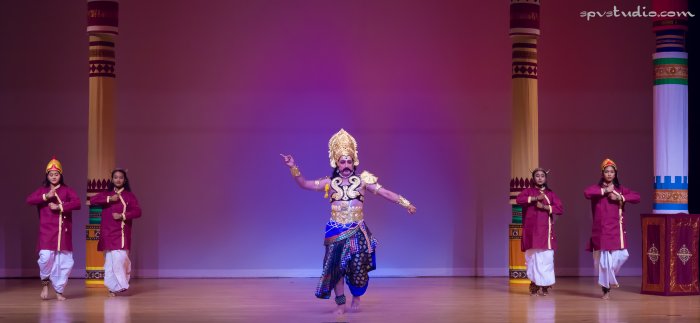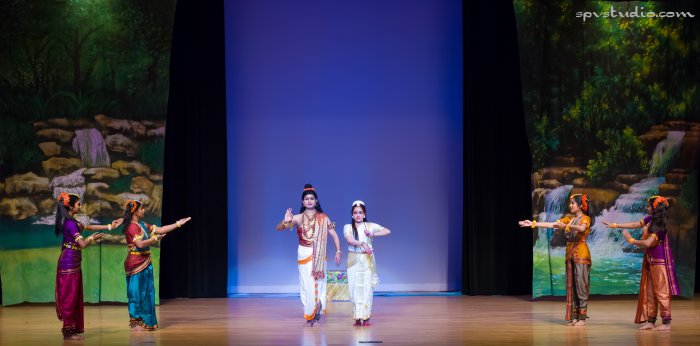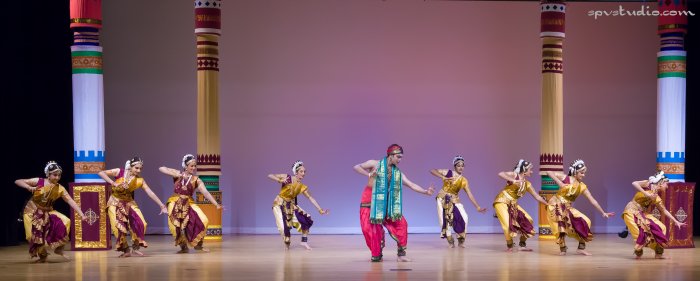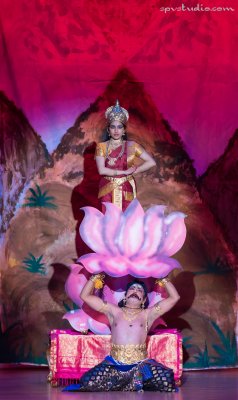
|   |

|   |
Datta Darshanam - Kalyani Raja e-mail: kpraja18@gmail.com April 17, 2016 Kuchipudi Kalakshetra, a premier Kuchipudi dance academy under the direction of Guru Padma Sonti, presented Datta Darshanam on March 26, 2016 at Granville Arts Theater in Dallas, Texas. Datta Darshanam was choreographed in the traditional Kuchipudi dance drama style featuring performances by Raghava Vedantam (Director for Vedantam Kalakshetram in Houston) as Jambasura and Venugopal Josyula (Assistant Director for Anjali Center for Performing Arts in Houston) as Dattatreya.   Datta Darshanam tells the story of Lord Dattatreya’s birth and depicts stories from his lifetime. After the traditional invocation dance to Lord Ganesha, the production opened with the introduction of Jambasura, a powerful demon who arrogantly claims that there is no one stronger or mightier than him. The scene then changes to the heavenly abode of Indra, the Lord of the Heavens. Indra is being entertained by his famous Apsaras, who are renowned for their beauty and grace. The four dancers that played the Apsaras were spectacular to watch and executed the complex dance sequence, choreographed by Padma Sonti, with precision and perfect synchronization. Jambasura interrupts the Apsaras’ dance and insults Indra, conquering him and ousting him out of his own court.  The scene then shifts to Atri and Anasuya’s abode. Anasuya, consort of Sage Atri, performs a penance for a hundred years. The Trimurthis (Brahma, Vishnu and Shiva) give Anasuya a boon that they themselves would be born to her as a son by the name of Dattatreya. The three dancers playing the trinity were truly divine in their respective roles. The playful dance piece where young Datta plays with other children was carried out well. Using clever props to depict flowing water in a river, the child Datta is shown as jumping into the river and then emerges as a grown man. He emerges with his consort Anagha, who later explains that she and Dattatreya are one. The dance between Anagha and Dattatreya was performed well to the melodious music. Anagha represents the supreme yoga and Datta is the crux of Vedas.  In the next scene, Dattatreya asks his mother Anasuya, for blessings to go to Sahyadri to preach to his disciples. Anasuya, unable to overcome her earthly bond with her son, demands that he stay put with her. Dattatreya reveals his Atma Jyoti and upon realizing that Dattatreya is detached to all worldly pleasures and relationships, Anasuya allows him to go to Sahyadri. Showing an actual bright light emanating from Datta was depicted beautifully using lighting techniques. The next few scenes are examples of disciples of Dattatreya and their devotion to him. Prince Kartheveeryarjuna displays steadfastness even after being crippled and losing his kingdom. In this scene, Raghava Vedantam depicts a drunken man, who is indeed Lord Datta in disguise. He verbally abuses Prince Kartheveeryarjuna just to test his faith. Lord Datta is pleased with the Prince’s steadfast devotion to him and blesses him with health and his kingdom. In the subsequent scene, the mood shifts to a more folk style. Gollabhama, a milkmaid and staunch devotee, who adores Lord Dattatreya in everything around her, provides clever answers to the poignant questions of the learned townsmen. At the end of this discussion, the learned men realize the divinity of Lord Dattatreya. Meanwhile, Jambasura is still terrorizing all the three worlds. Indra pleads with Lord Dattatreya to save his heavenly kingdom from the demon Jambasura. Indra is consoled by Datta and is advised to provoke Jambasura into a fight that will bring him to the Sahyadri Mountain. Accordingly, once Jambasura is at Sahyadri, Anagha captivates Jambasura with her beauty and voice. Jambasura falls in love with Anagha and requests her to marry him. She agrees only if he fulfills one condition, that he lift her and her abode onto his head. Jambasura confidently agrees, but is unable to do so as Anagha becomes heavier and heavier as he tries. Jambasura collapses under the weight and his demise is celebrated by Indra. The dance drama concluded with Dattatreya unveiling the truth to Indra that Anagha and Datta are one and the same – Body and Soul. Raghava Vedantam as Jambasura was a feast to watch. Raghava’s mastery of Kuchipudi was evident in his perfect depiction of both the demon King Jambasura and a drunken man. He embodied the characters so perfectly that you felt as if you were watching the actual mighty demon. Venugopal Josyula also demonstrated his technical skill and command over Kuchipudi through his depiction of Lord Dattatreya. It was evident that all the performers worked very hard and did a wonderful job with each of their characters. The melodious music was composed by DSV Sastry. Congratulations to Padma Sonti and Raghava Vedantam for choreographing and putting together such a mesmerizing and memorable dance drama. |